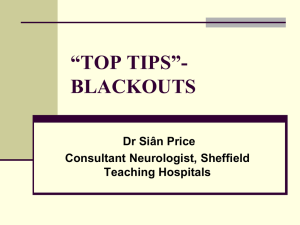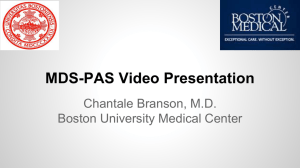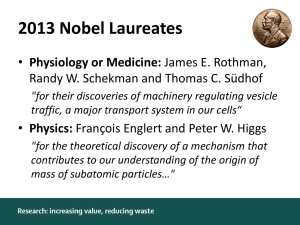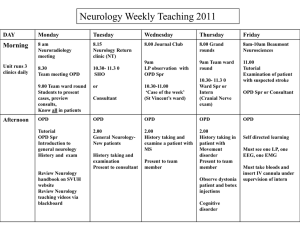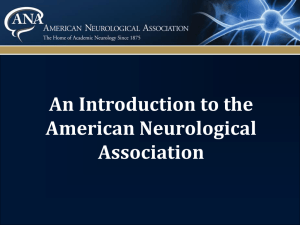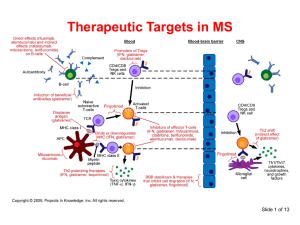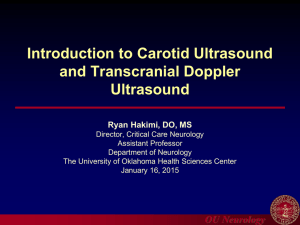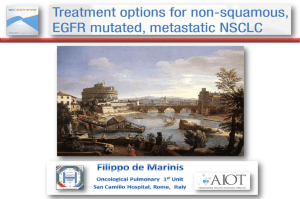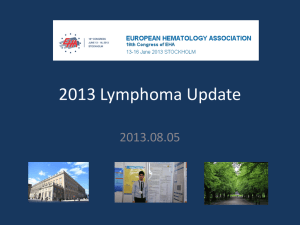When Does Huntington`s Disease Begin?
advertisement
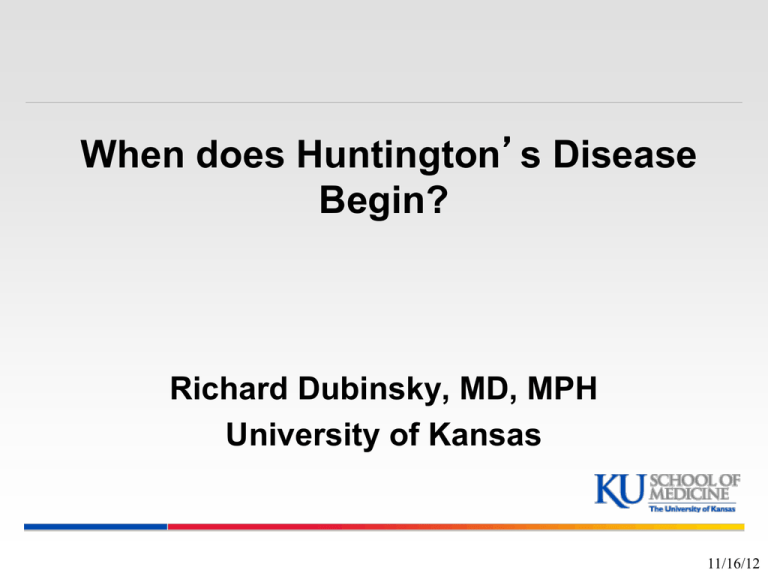
When does Huntington’s Disease Begin? Richard Dubinsky, MD, MPH University of Kansas 11/16/12 Disclosures Current NIH/NCAM and FDA Completed: NIH: CARE-HD, OPD 2CARE CRESTE CHDI ENROLL-HD Facilitator, redefining HD across the life span PHAROS, PREDICT-HD FDA: RID-HD HSG: Longitudinal database CHDI: COHORT HD Gene Cloned 1993,from the Venezuela project Trinucleotide repeat, one of the first three described CAG expansion Gene product huntingtin htt Ross C, Lancet Neurology 2011;10:83-98 CAGn Ranges <26 normal, 17 most common 26-29 rarely expand 30-36 expand, mostly 35 and 36 35-38 unstable expansion HD in future generations 39 and above: HD 80% of people with 39 repeats will develop HD What happened? Founder effect, maternal germ cell mosaicism Maternal transmission rarely changes CAGn Paternal transmission usually expands Mean expansion 6.2 Mean contraction 1.3 Lee JM. Neurology 2012;78:690-5 Onset of HD Traditionally defined as onset of chorea Always gradual, never sudden Cognitive, behavioral and motor changes can precede chorea Determining Clinical Onset Historical data Chorea Other domains: Behavior Cognition UHDRS-99 Copyright © HSG Ltd. HD: Juvenile Form Predominance of dystonic rigidity Early cognitive problems Prolonged survival http://promotingexcellence.org/huntingtons/ Is the initial symptom disease onset? Frequent phenoconversion after predictive testing 4 x > normal population suicide rate around phenoconversion HD is not protective against other disorders HD: Progression Total Functional Capacity Slope ~ 0.9/y Five domains Occupation (3) Fiscal (3) T Activities of daily living (3) Household chores (2) Residence (2) HD Disease Models Weir Lancet Neurology 2011;10:573-9 Ross C, Lancet Neurology 2011;10:83-98 Ross C, Lancet Neurology 2011;10:83-98 Ross C, Lancet Neurology 2011;10:83-98 Lee JM. Neurology 2012;78:690-5 Brinkman R Am J Hum Genet, 1997;60:1202-10 Brinkman R Am J Hum Genet, 1997;60:1202-10 Langbehn D, Am J Med Genet B Neuropscyh 2010;153B:397-408 PREDICT-HD Prospective cohort study of gene +, asymptomatic subjects and gene – controls Near (onset < 9 years) Mid (onset 9-15 years) Far (onset > 15 years) Yearly neuroimaging, cognitive and psychomotor testing Paulsen J, JNNSP 2008;79:874-80 Paulsen J, JNNSP 2008;79:874-80 Paulsen J, Brain Res Bull 2010;82:201-7 Aylward E, JNNSP, 2011;82:405 COHORT Multi-site, international natural history of HD People with HD, those at risk, family members, some children 2006-2011 Funded by CHDI Dorsey, PLoS 2012 Dorsey, PLoS 2012 Dorsey, PLoS 2012 Dorsey, PLoS 2012 Dorsey, PLoS 2012 Symbol Digit Modality / Stroop + ( ! < & ^ @ ) 1 2 3 4 5 6 7 8 @ @ ) ^ ( + ! + red green blue blue green red red green blue blue green red COHORT: Medication Use Dorsey, PLoS 2012 Dorsey, PLoS 2012 TRACK-HD Prospective, longitudinal cohort study Manifest HD Gene + (pre-manifest HD) Burden of pathology score Age x (CAG-35.5) > 250 Gene -, non-matched controls HD Cohorts PreHD-A and PreHD-B Dichotomized at median predicted years to diagnosis (Langbehn score) HD1 and HD2 Stage 1 TFC 11-13 Stage 2 TFC 7-10 TRACK-HD Baseline Characteristics Tabrizi S, Lancet Neurology 2009 Tabrizi S, Lancet Neurology 2009 Tabrizi S, Lancet Neurology 2009 ∆ in Brain Volume Tabrizi, S Lancet Neurology. 2012,11:42-35 Striatal volumes Tabrizi, S Lancet Neurology. 2012,11:42-35 Tabrizi, S Lancet Neurology. 2012,11:42-35 Tabrizi, S Lancet Neurology. 2012,11:42-35 Neuropsychological Tests Tabrizi, S Lancet Neurology. 2012,11:42-35 Tabrizi, S Lancet Neurology. 2012,11:42-35 Tabrizi, S Lancet Neurology. 2012,11:42-35 HD Clinical Trials Completed CARE-HD RID-HD TETRA-HD TREND-HD MINOS CYTE I PHEND-HD DIMEBOND 1 & 2 HSG Database PHAROS COHORT Ongoing 2CARE CRESTE-HD PRE-CREST REACH-HD PREDICT-HD Potential Treatments RNA Silencing Anti-sense oligonucleotides RNA interference Delivery Mechanisms RNAi injected into CSF Virus injected into: CSF Putamen Virus inserted into bone marrow Inserted via nanotube and heavy metal through the olfactory bulbs Bone Marrow Transplantation? Mutant htt expressed in many cells Inflammatory markers before and at phenoconversion Bone marrow derived cells get into the brain Lancet 2004;363:1432-7 Aronin N NEJM 2012;367-1753 Conclusion Changes that lead to HD start > 10 years before ‘phenoconversion’ Redefining the onset Research Clinical diagnosis Implications Huntington Study Group Sleep and HD Insomnia is very common Sun downing Delusions of not sleeping


